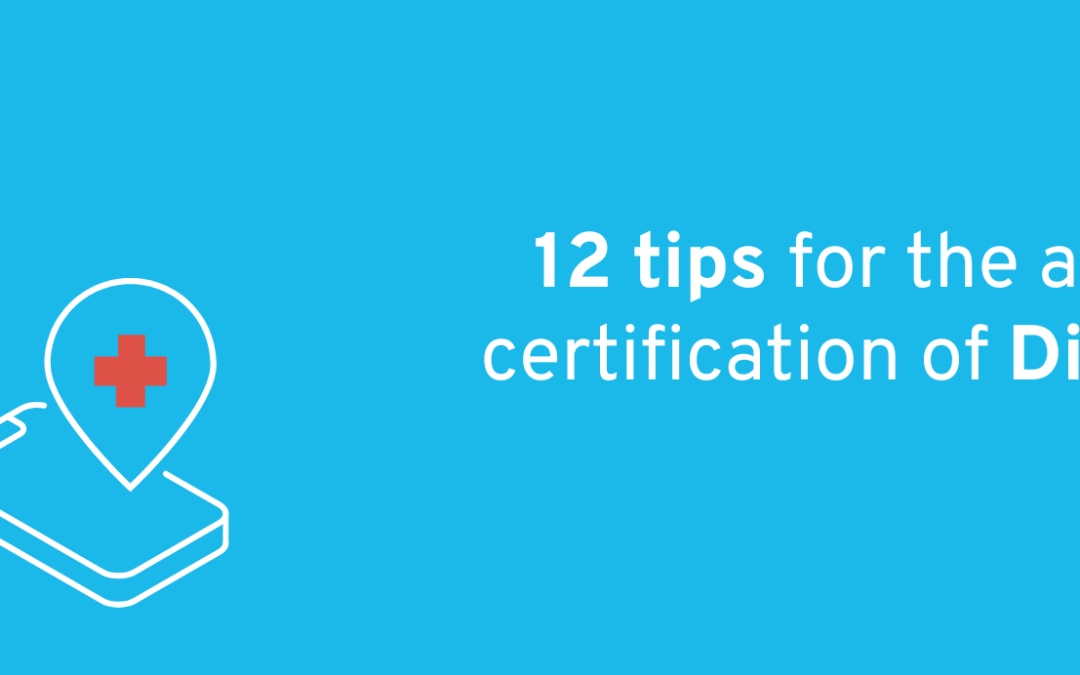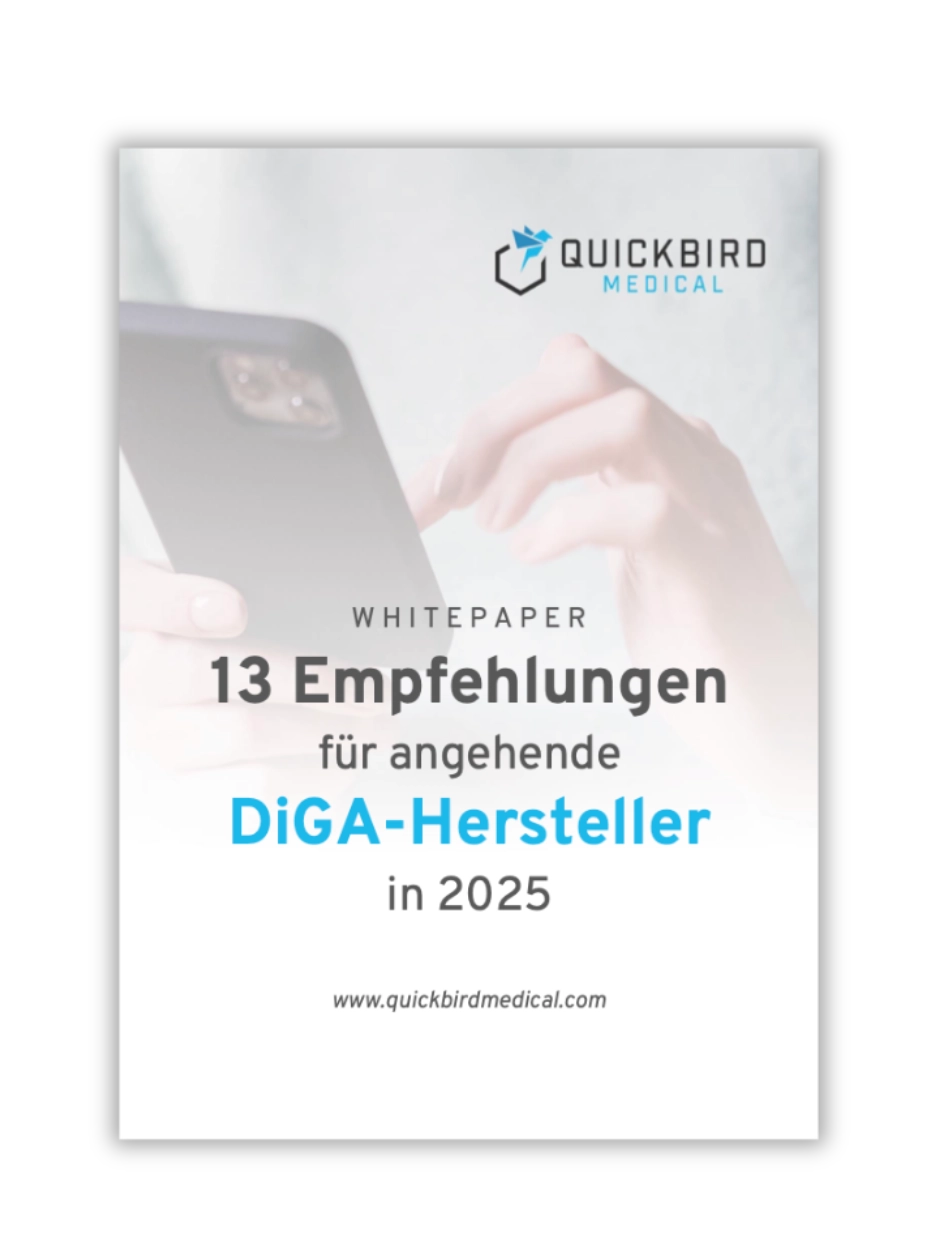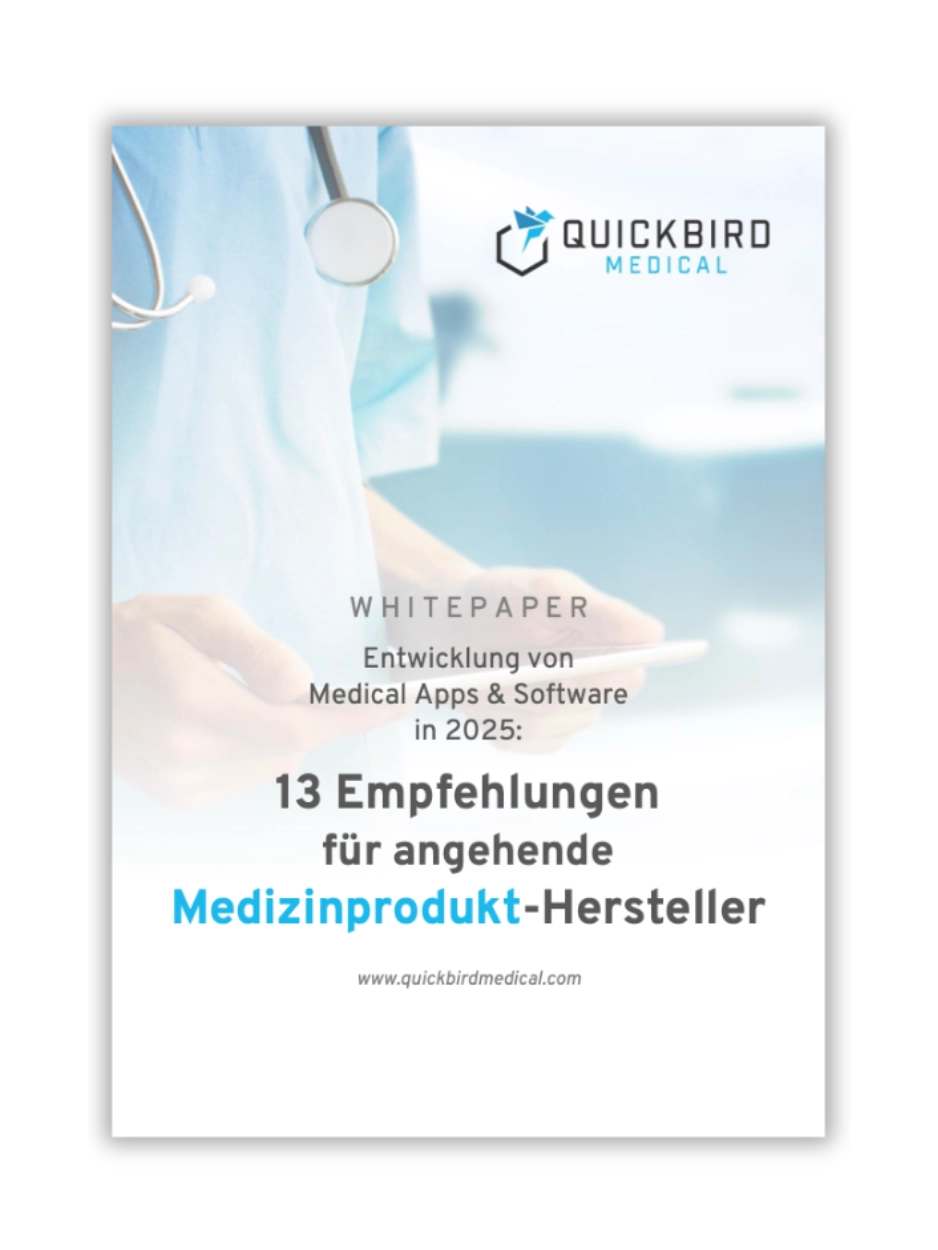Implementing a digital health application (DiGA) involves effort and costs that should ultimately pay off for your company.
And indeed, many certified DiGA that make it onto the market show extremely positive prescription and sales figures. Others, however, do not receive approval or fail before even submitting an application. But why is this the case? What factors influence the failure or success of your DiGA? In this article, we summarize the most important factors and recommendations you should consider in 2023 when planning, implementing, and obtaining approval for your DiGA.
Table of contents
- 1. The positive supply effect
- 2. Include BSI TR-03161 in your product concept planning stage
- 3. Plan your clinical trial adequately
- 4. Work with the right medical device consultants
- 5. Take advantage of the advisory services offered by the BfArM
- 6. Aim for risk class I
- 7. Use existing code to implement the ePA and Health ID connection
1. The positive supply effect
When developing and designing your DiGA, the focus should be on the positive effect on care. If your study ultimately fails to demonstrate a significant effect on the patient population, your DiGA will not be permanently included in the DiGA directory. This should therefore be the focus of all product design decisions.
Define study endpoints at an early stage
Define early on what positive treatment effect you are aiming for. Be as specific as possible. If necessary, define the primary and secondary endpoints of your study during the product planning stage.
Design with a focus on positive supply effects
Any product feature that does not directly contribute to increasing the desired care effect should be questioned. Getting listed in the DiGA directory is already a major challenge. Any additional product complexity increases your costs and time to market. You should only include additional features if they are very likely to have a positive impact on the care effect.
Use of existing evidence
When designing your solution, make use of existing evidence in your target indication area. Recognized guidelines provide a solid empirical basis, and established treatment methods are well researched. This means there is a good chance that you will also be able to demonstrate a positive impact on care with your digital solution.
Our recommendation:
For each product feature, ask yourself: “Does this feature have a positive impact on the care provided by my DiGA?” Features that are “nice to have” should be left out for now, and you should focus on the medically relevant product features.
2. Include BSI TR-03161 in your product concept planning stage
Since January 1, 2025, DiGA must be certified by an accredited testing agency in accordance with BSI TR-03161 before being included in the DiGA directory.
The security requirements of BSI-TR-03161 are extensive and, in some cases, have a profound impact on the technical concept and even the user interface of your DiGA.
However, making a fully developed DiGA BSI-compliant retrospectively involves significantly more effort than integrating the requirements into the technical planning from the outset.
The security requirements of BSI TR-03161 have an indirect influence, for example:
- The selection of software frameworks and libraries
- The technical architecture
- Selecting the server provider (keyword: “C5 certificate”)
- Encryption concept
- Technical communication of components
- Authentication methods
- etc.
Our recommendation:
If you want to save time and money, familiarize yourself with BSI TR-03161 before you start developing your software. Identify the requirements that have a significant impact on your technical concept and integrate them at an early stage. We would be happy to support you with consulting or development services (more information can be found here).
3. Plan your clinical trial adequately
There are many influential paradigms in the start-up sector that allow entrepreneurs to increase the probability of success of their own company:
- “Move fast and break things” (Facebook)
- “Responding to change over following a plan” (Agile Software Development Manifesto)
- “Fail Faster”
These mantras and strategies are extremely helpful and important in certain contexts. However, when it comes to planning a medical device or a digital health application, advance planning is significantly more important than in the traditional software startup sector.
Your DiGA must demonstrate its positive impact on care in a clinical study in order to remain listed in the directory. These studies are very time-consuming and costly, which is why the budget is often only sufficient for one or two studies. This means that you can only try out or evaluate a limited number of product approaches. The pressure is mounting that the first approach must be the right one. Accordingly, you need to plan sufficiently to increase the probability of success of this approach.
The planning of the DiGA should, of course, also take into account the results of any qualitative and quantitative user research. You can consider different approaches at the beginning. However, once you have decided on one, it is much more difficult to change direction.
Apart from product design, it is also important to pay attention to quality in the study. As you are surely aware, you must conduct a comparative study.
Among other things, the following questions need to be answered here:
- How large should the sample be?
- For which patient group (ICD code) do you specifically want to obtain evidence?
- How do you gain access to this patient group?
- What is the current reality of their care?
- What are the ethical concerns about the study?
- How many comparison groups do you need?
- What is the procedure for assigning test subjects to groups?
- Which specific endpoints should be measured – and how do you want to collect them?
- How long must the DiGA be used to demonstrate a positive supply effect?
- What supply effect should your DiGA actually achieve?
For the clinical trial, it is best to find a reliable partner who already has experience with DiGA and software trials (we are happy to help you select a CRO from our network of contacts – just send us a quick message).
In addition, price negotiations with the GKV-Spitzenverband (National Association of Statutory Health Insurance Funds) are scheduled for after the end of the trial period. This will determine how lucrative your application will be in the long term. The quality of your study and the strength of the positive care effect are extremely important negotiating arguments that will enable you to achieve a permanently higher DiGA price.
Our recommendation:
Check whether there is existing scientific evidence suggesting that your DiGA can demonstrate a positive effect on care – and if so, what this effect looks like. Conduct initial qualitative and quantitative studies to generate additional data for product design. Also, plan the study design (with a CRO, if necessary) really well so that you don’t have any surprises during or at the end of the study. The more rigorous your methodological approach, the greater the chance of obtaining permanent approval and negotiating a higher price for your DiGA.
4. Work with the right medical device consultants
A DiGA must be approved as a medical device before the application can be submitted. In the medical device sector in particular, you should seek out partners who can provide you with targeted advice. Poor advisors will cost you a lot of time and money. Good advisors will help you get to market quickly and cost-effectively.
Unsuitable advisors can be identified by the following characteristics, for example. They…
- … have little prior knowledge of standalone software. The consultants come from the hardware sector, for example, and have difficulties understanding the complexity and mindset of standalone software development.
- … have no experience with agile development, especially not in relation to medical products.
- … explain things in an unnecessarily complicated way and do not show a clear path to implementation.
- … artificially drive up consulting costs by making themselves irreplaceable. They block the transfer of knowledge to your company either knowingly or unknowingly.
Good consultants, on the other hand …
- … find pragmatic solutions that can be implemented creatively and concretely. Good consultants know the rules and how to follow them without wasting resources.
- … develop solutions that fit into your company instead of imposing their standard procedures on you.
- … explain things in simple language and thus enable knowledge transfer to your team. Good consultants gradually make themselves redundant, so that your team can eventually stand on its own two feet.
- … do not organize a workshop lasting several days for every little problem, but help efficiently to find a solution.
Don’t forget that every month you are not listed as a DiGA, you are not making any money, but you still have costs. Therefore, good advice is absolutely integral to the success of your product.
Our recommendation:
Be aware of the above issues and exercise caution when selecting your advisors. We would be pleased to assist you with our network and refer you to trustworthy advisors for your specific situation. Simply contact us using our contact form.
5. Take advantage of the advisory services offered by the BfArM
For product-specific DiGA questions, you should contact the BfArM. Of course, you should first try to answer the questions yourself by studying the BfArM guidelines and the DiGAV. However, some questions are so individual that you will need a case-specific assessment from the examiner (the BfArM).
So don’t hesitate to book a paid consultation with the BfArM for this purpose. If you have prepared your questions well, you will receive important answers that could determine the success of your listing in the directory.
But be careful!
Waiting times for consultations with the BfArM can be extremely long. You should expect to wait at least six months for an appointment.
Our recommendation:
The BfArM guidelines and cooperation with consultants will answer most of your questions. However, for product-specific key questions, you should contact the BfArM to avoid surprises during the review process.
6. Aim for risk class I
There is currently still uncertainty as to whether software medical devices in risk class I will continue to exist under MDR in the future. We describe the current situation (as of 2025) in our technical article here.
In summary: There is a legal gray area with room for interpretation. However, in many federal states, approval under risk class I is currently still possible.
To date, for example, almost all applications approved under MDR are classified as risk class I in the DiGA directory. You can get a concrete overview of this in our DiGA directory for manufacturers.
Whether your medical device falls into risk class I depends on various factors. Please read the article mentioned above for more information.
In general, software in risk class IIa involves considerable additional effort and costs for certification by a notified body. It may be worthwhile to define the application and, above all, the intended purpose in such a way that your product falls under risk class I.
We are, of course, fully aware that it is not possible to make such a change to the concept for every product. However, as it can often work, particularly for products used by patients, it may be worth considering this point.
We would be happy to advise you on this and evaluate whether risk class I could work for your product.
Our recommendation:
Define the intended purpose of your application in such a way that classification as risk class I is potentially possible. From risk class IIa onwards, you will face considerably more effort. In an emergency, you can upgrade your product to risk class IIa at a later date and find a notified body for this purpose.
7. Use existing code to implement the ePA and Health ID connection
Connecting to the electronic patient record (ePA) and the health ID can be a considerable challenge—especially for companies dealing with these interfaces for the first time. The technical specifications are complex, and the official documentation is extensive and sometimes difficult to understand.
But there are shortcuts: Instead of laboriously working your way through the specifications and developing your own implementation from scratch, it is worth relying on existing code and technical advice. Working with a partner who already has experience with integration not only saves development effort, but also reduces the risk of implementation errors.
Our recommendation:
Take advantage of existing implementations and the expertise of experienced partners to efficiently implement ePA and health ID connectivity. This allows you to avoid lengthy trial-and-error phases and focus on the actual development of your product more quickly.
QuickBird Medical offers both reusable technical components and technical consulting services. More information can be found here.
You can find six more DiGA tips in our white paper…
You can find all further tips on approval and certification in our DiGA white paper. Simply download it using the form.
Conclusion
Increase the probability of success of your DiGA
Due to regulatory hurdles, developing a DiGA is not a task that should be underestimated. However, with good planning and the right advice, you have a good chance of getting your product approved for inclusion in the DiGA directory. We hope that the above recommendations for DiGA approval will help you avoid unnecessary effort and potential risks.
Further information on topics such as the DiGA approval process, proof of positive healthcare impact, and price negotiations can also be found in our DiGA and Medical Software Blog.




